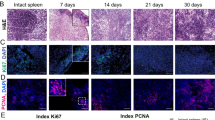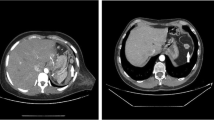Abstract.
Loss of the spleen may lead to fatal bacterial infections. As a preventive procedure splenic autotransplantation has been performed in humans and experimental animals. However, there is still controversy about the protective function of this procedure, partly because the process of regeneration after implantation of splenic tissue is not fully understood. In the present study the question was addressed of whether, in contrast to the current view, leukocytes survive the phase of necrosis after implantation of splenic fragments. Rats (LEW.7A; host) received splenic fragments of a congenic rat strain (LEW.7B; donor). These fragments first underwent almost complete necrosis, then regenerated, finally developing the typical splenic compartments. Twenty weeks after implantation, leukocytes which had survived the implantation procedure (7B positive; donor) and those which had migrated from the host into the splenic implant (7B negative; host) were differentiated using a specific monoclonal antibody (anti-7B) and immunohistology. In addition, the rats received 5-bromo-2-deoxyuridine (BrdU) 1 day before the splenic autotransplant and several lymphoid and non-lymphoid organs were removed. This thymidine analogue is incorporated in proliferating cells during the S-phase of the cell cycle and can be revealed by immunohistology. The present study demonstrates that macrophages and B and T lymphocytes survive the implantation procedure and are found in the organ compartments of the splenic autotransplant. The lymphocytes proliferate and migrate into lymphoid and non-lymphoid organs. Both the number of surviving leukocytes in the splenic autotransplants and the number of donor lymphocytes found in various host organs varied considerably between single animals. Thus, not only fibroblasts but also macrophages and lymphocytes survive the avascular implantation of splenic fragments. The surviving leukocyte subsets may be involved in the regulation of the regeneration of the different splenic compartments, so increasing their numbers may finally lead to an improvement in the function of splenic autotransplants in the clinical situation.
Similar content being viewed by others
Author information
Authors and Affiliations
Additional information
Received: 25 June 1996 / Accepted: 5 September 1996
Rights and permissions
About this article
Cite this article
Westermann, J., Pabst, R. Autotransplantation of the spleen in the rat: donor leukocytes of the splenic fragment survive implantation to migrate and proliferate in the host. Cell Tissue Res 287, 357–364 (1997). https://doi.org/10.1007/s004410050761
Issue Date:
DOI: https://doi.org/10.1007/s004410050761




